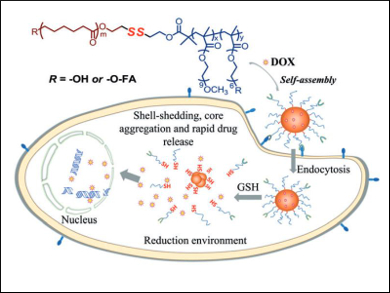To achieve enhanced therapeutic efficacy and reduced side effects during cancer treatment, much effort has been dedicated to the development of intracellular, reduction-responsive, polymeric micelles that can release loaded drugs in response to reductive glutathione in certain cancer cells.
Yanli Zhao and colleagues, Nanyang Technological University, Singapore, reported a simple and versatile approach to fabricate reduction-responsive, shell-sheddable, copolymer micelles for targeted anticancer drug delivery. The copolymer was prepared with controlled molecular weight and integrated functionalities using a double-headed initiator consisting of a disulfide linkage and a folic acid targeting unit. The micelles were then formed and loaded with the anticancer drug doxorubicin by self-assembly.
After uptake into the cytoplasm of HeLa cells, the drug load was released by reduction of the micelles by glutathione, and cell growth was consequently inhibited. The micelles have several advantages, including easy synthesis, high stability, and reduction-triggered rapid drug release, which demonstrate their effectiveness as drug delivery vehicles in cancer treatment.
- Intracellular Reduction-Responsive Sheddable Copolymer Micelles for Targeted Anticancer Drug Delivery,
Yuanyuan Zhang, Qiuyu Qu, Menghuan Li, Yanli Zhao,
Asian J. Org. Chem. 2014.
DOI: 10.1002/ajoc.201402146




